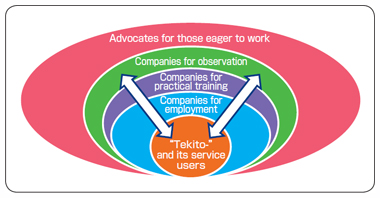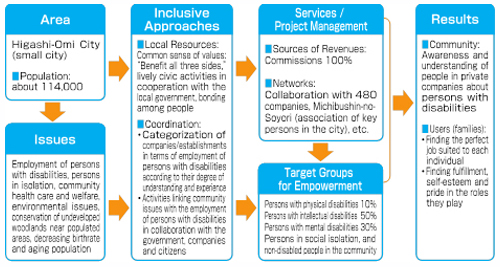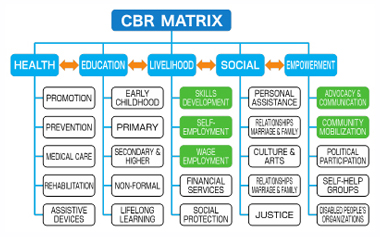Community-Based Inclusive Development
CBID Good Practices
“Tekito-” Higashi-Omi Region Employment and Life Support Center
(Higashi-Omi City, Shiga Prefecture)
Key Words Encounters, Company networks
In collaboration with as many as 480 companies and establishments, “Tekito-” supports by way of employment the lives of persons with disabilities and people who have withdrawn from society. In Higashi-Omi region people actively participate in civic activities. Taking advantage of this local trait, it creates opportunities from encounters with various companies, establishments and civic activities. Through these encounters, “Tekito-” also deals with other community issues besides disability.
◆Background
Higashi-Omi City, where we are active, has long had a tradition of holding lively civic activities in cooperation with the local government, based on the traditional concept of “sanpo-yoshi (benefit for all).” Yet, the city faces issues common with many other small cities in Japan, such as the increasing number of young people with economic difficulties or social isolation not limited only to persons with disabilities.
◆Service Outline
Employment and Life Support Center “Tekito-” was established in 2006. It plays the same role as the Employment and Life Support Center for Persons with Disabilities in the national government system, which means it provides the necessary support for the employment and daily living of persons with disabilities. Specifically, it provides them consultation services and advice on these matters; and at the same time companies and establishments that employ persons with disabilities may also consult in this center. Beyond consultation services, “Tekito-” has formed a mechanism to support persons with disabilities working in the community.
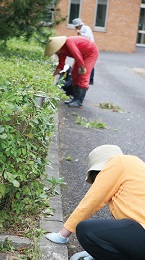
Weeding work at a local library compound impresses the people in the community.
Basic Data
●Coverage Area: Higashi-Omi City, Shiga Prefecture (a small city)
●Population: about 114,000
●Issues: Employment of persons with disabilities, social withdrawal, community health care and welfare, environmental issues, conservation of undeveloped woodland near populated areas, declining birthrate and aging population
■Year of Establishment
Established in 2006.
■Contents of Services
As for the types of disabled service users that “Tekito-” serves, persons with intellectual disabilities account for the largest number. Some other disabilities are physical, mental, developmental and higher brain dysfunction. A big portion of the service users, with or without disabilities, are the socially isolated who have withdrawn from society for a long time.
“Tekito-” provides all kinds of work-related support, such as the provision of employment development, follow-up after referrals, and consultation on day-to-day matters. Among other things, “Tekito-” emphasizes support at the time towards employment.
During this time of preparation of employment, we give step-by-step assistance to the service users, such as conducting company tours, practical training until they are finally employed. For instance, persons with disabilities who do not have work experience or persons long withdrawn from society can start with small steps towards employment by observing the differences between the home/school environment and the company environment.
To concretize this step-by-step support, we categorize companies and establishments according to the degree of their understanding and experience of hiring persons with disabilities. Establishments are selected according to the following purposes: observation, practical training and employment.
We believe that aside from giving persons with disabilities these opportunities, recognizing their eagerness to work is also important. With this in mind, we post stickers at various places in the community to support their eagerness to work.
Through these activities “Tekito-” concentrates its efforts on coordinating job opportunities between those with physical and social impairments and company people.
■Special Festures
The steps towards employment mentioned above (observation → practical training → employment) are not only small steps for those with physical and social impairments but also small steps for the companies to take until they finally employ them.
For companies that do not have any exposure to persons with disabilities, allowing them to come in for observation visits can be a good introduction. With this starting point and after repeated visits, we develop a relationship with the companies and move on to practical training and employment according to their degree of understanding and preparation for the employment of persons with disabilities; thus establishments can play certain roles depending on their stage of readiness for employment.
In establishing relationships with companies willing to give employment support, “Tekito-” makes use of various opportunities such as meetings with the President of the Chamber of Commerce and the assemblies of labor unions. When visiting Higashi-Omi City Hall, “Tekito” staff visit departments not related to disability matters much more frequently than the welfare department which is more directly concerned with the support for persons with disabilities.
Moreover, as an effort to broaden and deepen its ties with companies/establishments, “Tekito-” has formed an association composed of their Presidents. Furthermore, an association of general managers and another of section managers have been formed to establish a multi-layered relationship.
When “Tekito-” was established, there were only a few companies/establishments that employed persons with disabilities in Higashi-Omi. No one ever imagined persons with disabilities to be working for them.
Through the endeavors mentioned earlier, as many as 480 companies/establishments currently support persons with disabilities or social problems in one way or another in their job placement in collaboration with “Tekito-.”
It is the local trait of the people of Higashi-Omi City that provided the social environment that enabled “Tekito-” to form ties with a wide range of companies/establishments for this program.
In Higashi-Omi City, civic activities actively cooperating with the municipal government have long been held in the Omi merchants’ spirit of pride that “benefits all three (the customer, vendor and community).
A detailed explanation of the civic activities is captured by a civic activity map called “Higashi-Omi Michibushin Mandala,” which is published by the “Michibushin-no-Soyori,” comprising the key persons in Higashi-Omi.
It is overwhelming to note that people with diverse backgrounds, including those working in companies, government, health care and welfare, are tackling various challenges in other fields such as, environment, sustainable energy, disabilities, children, foreigners, and industrial promotion.
“Michibushin-no-Soyori” holds parties, though irregularly, called “big exchange meetings” that involves more than one hundred attendees. This is an opportunity for people related to the civic activities in Higashi-Omi to meet together resulting in new ties and new activities.
“Tekito-” is able to expand its services through close contact with the people behind Higashi-Omi’s civic activities and by attending the “big exchange meeting” where new ties are generated with new companies/establishments, and further deepening those relationships with key persons that sometimes leads to other community issues being addressed, besides the issue of employment of persons with disabilities and its related concerns.
One example of this is the “Maki (firewood) Project,” which will be shown in the next chapter.
In summary, “Tekito-” focuses its efforts on coordinating encounters between persons with disabilities and persons in isolation with companies, establishments and other people in the community. It arranges meetings and creates ties with them by attending various occasions.
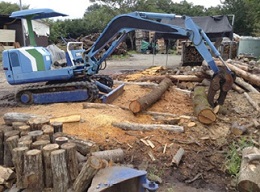
Gathering firewood
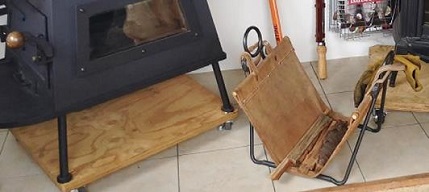
Sold and used firewood
◆How Things Changed
One of the challenges many small municipalities have in common is the issue of conservation and management of copse. This is due to the change of industrial structures and the lack of successors in the forestry industry because of the decreasing number of children and the aging population, resulting in the devastation of undeveloped woodland near populated areas and the increase of damage caused by animals in rice fields and others.
In Higashi-Omi, this challenge of conservation and management of copse started being addressed with a civic activity. Later, to utilize felled wood generated through the activity, concerned residents formed an establishment to develop and sell wood-burning stoves. They tried to create a system to conserve and manage the copse sustainably by diffusing the wood stove around the community and distributing the felled wood as firewood.
The process of making firewood from felled wood is burdensome work. Somebody has to process it into firewood for it to sell. However, the amount of work is not big enough to hire someone permanently just to make firewood.
Having been informed by a concerned local government officer that there was an establishment in trouble over making firewood, “Tekito-” came up with a way to resolve the issue – which is to turn firewood-making into a work opportunity for persons with disabilities or those in isolation.
Making firewood does not require precision or perfection, and so there is no such thing as to “fail” in the process. Many realized that it is a suitable job opportunity for persons with disabilities or persons in isolation. Those who are not good at having interactions with other people easily adjust to the working place with little pressure, since they cannot talk in the first place due to the noise from the machines.
Due to the characteristics of the firewood-making process, the establishment gradually came to employ some people. Although in the beginning the people at the establishment felt awkward working with persons with disabilities and social problems, they grew in understanding as time went by. Now, if anything happens to them, our service users, the people at the establishment notice it immediately and feel concerned.
The service users who at first did not speak to anyone were later observed to have started mingling with others. It is thought that their behavior has changed because of their confidence gained from having a role in society.
The firewood-making project is one of the examples that demonstrate how the needs of both the establishment and persons with disabilities are met by the initiative to tackle community issues by connecting them with the need of persons with disabilities for employment, while utilizing the networks among the municipal government, establishments and citizens.
■Current lssues and Way Forward
(Excerpt from the interview with Ms. Mitsuko Nonomiya, Center Head)
Through the endeavors stated above, there is one thing that should be considered important for the future of our community – the perspective of the people who are labeled as “withdrawn from society” the ones who cannot live or work in the same way as others can.
Instead of showing disapproval of the time seemingly wasted by the person in withdrawal or regarding this wasted time as a big issue, if the community could consider these persons as being the ones who has power to survive in isolation, I am sure that such kind of perspective towards inclusion would help to resolve depopulation and population aging.
Another way of looking at it is to imagine that all the people in the community can be “cheer leaders” while specialists are not available.
I think that work is an area where individuals and the community encounter each other.
In the future, besides the continuation of our services and expansion by creating more centers, what we plan to do next is to secure employment and a happy life for retired persons.
The happily retired are those who wish to be neither always at home nor employed by a company – for instance, persons with disabilities who retire at the age of 60 or those who came out into the society for the first time in 30 years at the age of 55 years old. We are trying to make a system to secure their employment and help them acquire a stable income.
In the process of resolving difficulties, jobs are created. I think it is important for people to keep working and stay active.
I would like to see things in interesting ways, not just in terms of meeting a need, but also in seeing how linkages are created by things that are less than perfect.
■Analysis Using the CBR Matrix
By measuring the activities of “Tekito-” against the CBR Matrix, the components and elements yet to be achieved are not many. That is because of the program of “Tekito-” giving support to persons with disabilities and those in isolation who have limited opportunities for employment.
As shown in the following matrix, it can be said that “Tekito-” is associated with “skills development,” “income generation” and “wage employment” under the “Livelihood” component, and then “advocacy and communication” and “community mobilization” under the “Empowerment” component.
Moreover, as for the activities under “Livelihood,” since “Tekito-” does not have its own workshop or company, it therefore does not provide places for “skills development” “income generation” and “paid employment” directly to persons with disabilities or those in isolation. “Tekito-” achieves these targets in an indirect way through “coordination.”
However, it does not mean that the value of these achievements is low just because of its indirect link to those specific fields.
On the contrary, it means that even if indirect support such as mere coordination had a ripple effect onto the other elements in the Matrix, it is therefore possible for persons with disabilities to achieve empowerment, engage in communication with non-disabled persons, and impact the community.

